| Article ID | Journal | Published Year | Pages | File Type |
|---|---|---|---|---|
| 1325382 | Journal of Organometallic Chemistry | 2007 | 12 Pages |
The Ru(II) phenyl complex TpRu(PMe3)(NCMe)Ph {Tp = hydridotris(pyrazolyl)borate} reacts with isonitriles to form complexes of the type TpRu(PMe3)(CNR)Ph (R = tBu, CH2Ph, CH2CH2Ph). Neither thermal nor photolytic reactions of these systems with excess isonitrile and benzene resulted in the production of corresponding imines. DFT studies that probed the energetics of the desired catalytic transformations revealed that (Tab)Ru(PH3)(CNCH2CH2Ph)Ph {Tab = tris(azo)borate} is the most stable species in a proposed catalytic cycle. Exclusive of calculated transition states, the highest points on the calculated free energy surface are 34 kcal/mol, for (Tab)Ru(PH3)(o,η2-C,C-CNCH2CH2Ph)Ph {relative to the starting material (Tab)Ru(PH3)(CNCH2CH2Ph)Ph}, and 27 kcal/mol for the C–H activation product (Tab)Ru(PH3)(o-C6H4CH2CH2NC) and benzene. The substantial increases in free energy result primarily from the loss of the stable ruthenium–η1-isonitrile interaction.
Graphical abstractThe Ru(II) phenyl complex TpRu(PMe3)(NCMe)Ph {Tp = hydridotris(pyrazolyl)borate} reacts with isonitriles to form complexes of the type TpRu(PMe3)(CNR)Ph (R=tBu, CH2Ph, CH2CH2Ph). Consistent with experimental studies, DFT calculations revealed that intramolecular hydroarylation of β-phenethylisonitrile to produce imine is a high energy process due to the strong coordinating nature of the isonitrile.Figure optionsDownload full-size imageDownload as PowerPoint slide
